Innovations in automotive design and manufacturing mean cars nowadays are very different from those of the past. With electric vehicles becoming increasingly common, it’s no longer unusual to see a row of cars parked at an EV charging station. New technologies develop all the time and cars in 2023 have some seriously advanced features.
But what will the cars of the future look like and what will they be able to do? To find out, we at DiscoverCars.com asked an expert in electromechanical system design and engineering to share their predictions with us. Based on their research and experience, we wanted to know about how cars might look and function in the future, as well as what they would be like to drive. The expert was able to share fascinating insights with us about possible advances in automotive materials, AI technology and sustainable energy sources, among other topics. Then, we used this information to prompt the AI image generator, Midjourney, to visualize cars in 10, 25 and 50 years’ time.
Car exterior — side view
2033

Based on our expert’s predictions, cars in 10 years’ time will still look quite familiar, and resemble some of the high-end super cars usually reserved for the rich and famous. Advances in materials could increase the use of carbon fiber, graphene and composites in automotive manufacturing. Cars made of these strong, lightweight materials might look streamlined and aerodynamic.
Headlights and tail lights that use OLED (Organic Light Emitting Diodes) may also become more frequently seen. These thin, flexible sheets of film produce solid panels of light, and can produce quite a futuristic look. They are already used in automotive design today (often as a visual clue that the car is an electric vehicle) but in the future they may well be used more widely because of the attractive quality of the light they produce.
2048

In 25 years’ time, cars could have modular designs that can ‘shapeshift’, changing automatically to respond to weather conditions, or becoming more aerodynamic for increased speed. Features like spoilers and vents might be able to adjust themselves dramatically without the driver’s prompting.
Solid-state battery technology may well have developed to a point where it can be used in cars. At that point, electric vehicles using the new energy efficient batteries would become cheaper to run than cars with a traditional combustion engine. Solid-state batteries could also make cars more lightweight because due to their increased energy density, they would not need to take up as much space in the car. This technology would also decrease the amount of time it takes for the battery to reach full charge.
Augmented reality could be used to display information about the car on its exterior – or enable drivers to apply temporary designs, such as a symbol that could help them find their vehicle in the car park. This could also help taxi drivers and their passengers find each other, by displaying a unique code on the body of the car.
2073

Cars in 2073 might start to look very different. VTOL (vertical take-off and landing) technology already in development might be applied to personal vehicles or taxis, meaning drivers could also fly their cars.
While people have been predicting flying cars for decades now, they are beginning to feel a lot more real. Some early models of flying cars are already approved by the US Federal Aviation Administration, so it is not too much of a stretch to suggest that in 50 years’ time vehicles like these might be a common sight on the road or in the air!
When cars that can fly are available for consumers, it could change the face of international travel – someone might rent a car with VTOL capabilities for a holiday where they plan to travel between islands.
With a highly modular, customizable exterior, cars in 50 years’ time could be capable of taking on all types of terrain. Drivers would be able to travel equally easily in the city or on a weekend getaway in the mountains.
Sensor technology will continue to develop, meaning cars will have increasingly advanced abilities to sense obstacles, other road users and weather conditions. The types of cameras included in cars may become more and more powerful and might be boosted by AI that can decipher visual information.
Cars in 2033 might also have improved object recognition, working in conjunction with the sensors to make driving safer. This could have all sorts of uses, from speeding up parallel parking to setting drivers’ minds at ease about sharing the road with pedestrians and cyclists at night.
LiDAR, a type of sensor already in use, sends out laser signals in rapid pulses and is capable of measuring the distance, size, speed and direction of an object among other attributes. It can work at short, medium and long distances. As technology develops, LiDAR sensors will no doubt become more lightweight and easy to integrate into vehicles, so that drivers can reap the benefits.
2048
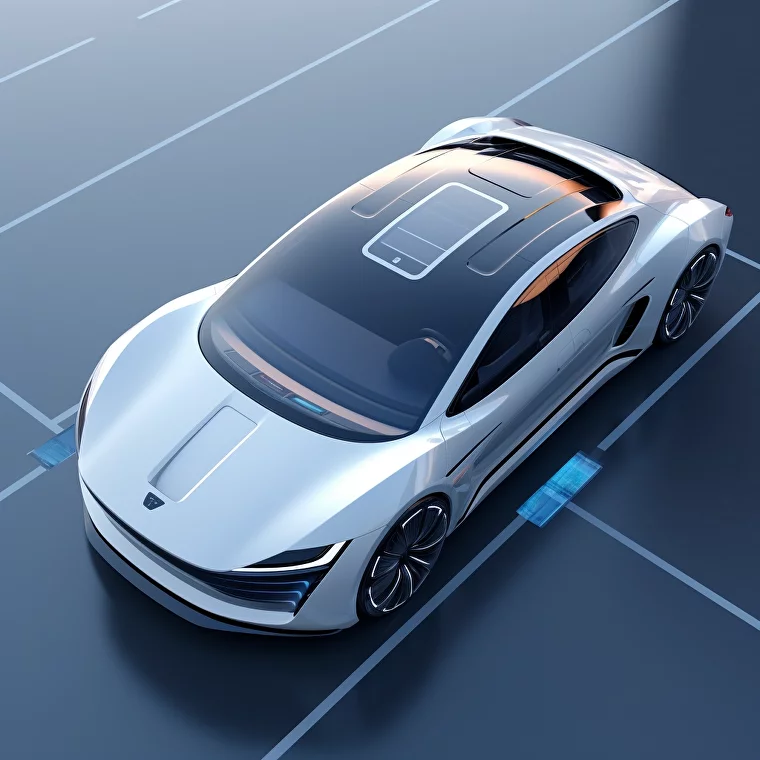
Cars in 25 years’ time might utilize solar power, with lightweight and flexible solar panels integrated into the roof and body of the vehicle. A solar-powered car would be very environmentally friendly and would be particularly useful in countries that get a lot of sunlight. Drivers could park their cars to charge in the sun, and they could even charge up while driving.
By 2048, we could be driving cars that are made partly from self-cleaning or even self-repairing materials, making vehicle maintenance easier and cheaper. Smart materials that can repair damage, seal cracks or return to their original form are already being developed and experimented with, usually polymers. Cars with a self-healing coating would be able to easily maintain a fresh and glossy appearance, despite everyday wear and tear.
Experiments are already taking place into developing a special coating for automotive bodywork that repels dirt and water. If this was available as standard, cars would effectively clean themselves due to the coating maintaining a miniscule layer of air between the paint and the environment.
2073
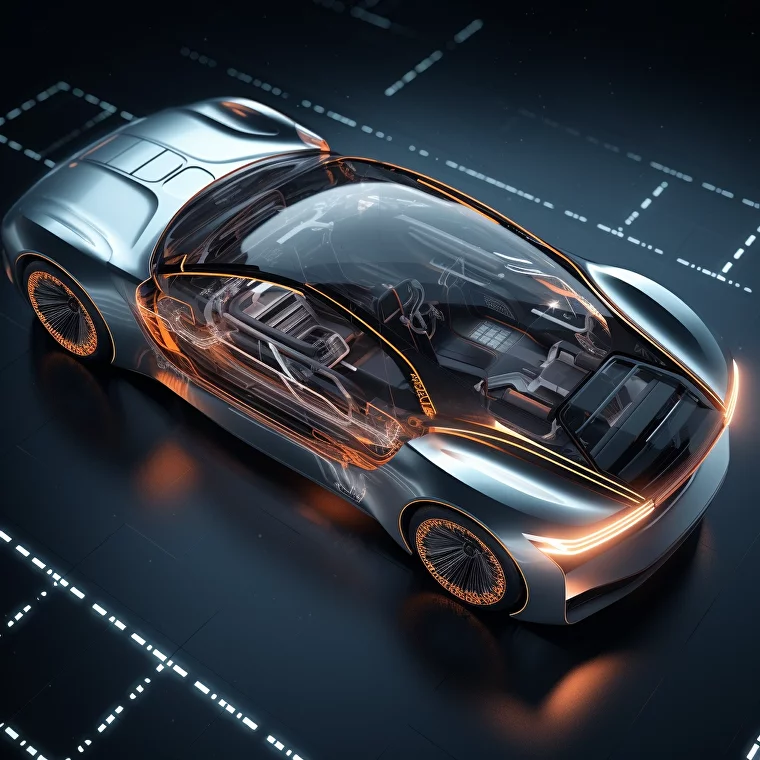
Magnetic levitation might enable smooth and frictionless travel that would reduce car sickness, or even allow cars to hover above the ground. In 2022 in China, cars with magnetic levitation technology were taken for test drives where they floated 35 mm above the ground.
Cars equipped with this technology would be able to hover above the road indefinitely, provided the road was also magnetized. Due to cutting out the force of friction, these cars would be incredibly energy efficient.
In 2073, transparent materials might be used to improve the driver or rider’s view and create a car with a futuristic and eye-catching appearance. These transparent materials might also be able to become opaque at the driver’s discretion, making the car super customizable and allowing drivers to express themselves differently every day using their car’s appearance.
Car interior — dashboard
2033
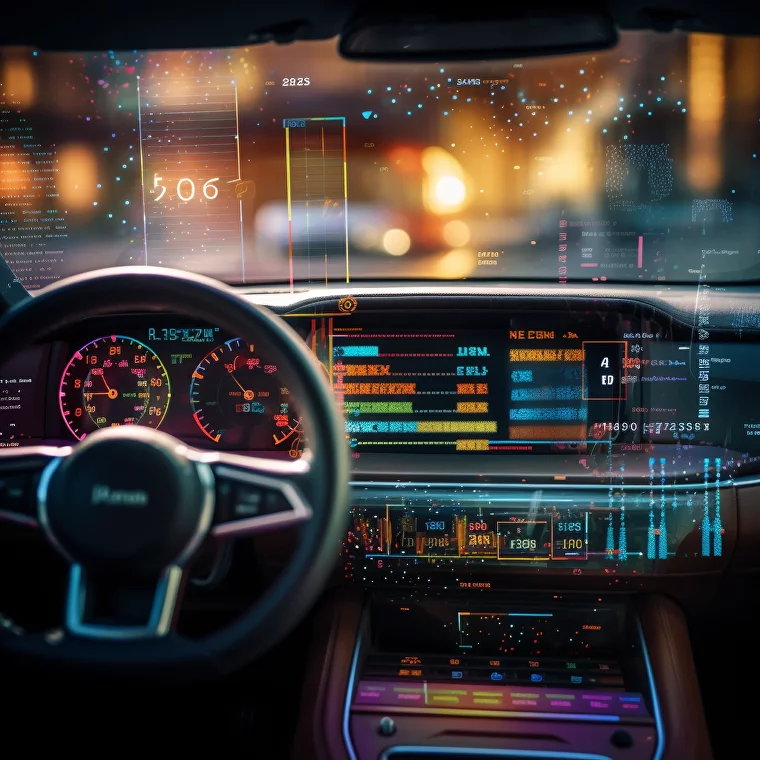
AR head-up displays could convey information to the driver without them having to look away from the road. With this technology, images, text and animations could be projected onto the windshield. Some automotive manufacturers are already including a version of this feature, using it to display a suggested route.
This technology can only become more advanced and more affordable over time. In the years to come, we could see AR head-up display technology being used for different purposes. Perhaps driving instructors could attend lessons virtually and advise their students from the corner of the windshield with visual prompts.
The dashboard of a car in 2033 might display vehicle-to-vehicle data, such as traffic information, to help the driver select the most efficient route. It could also show data from advanced sensors, keeping drivers aware of the average speed of other vehicles on the road or anything else they might need to be aware of in order to drive safely.
While fully autonomous vehicles may not yet be available by 2033, the technology will undoubtedly have developed, with cars perhaps integrating some self-driving features. This might take the form of improved cruise control, removing the need for the driver to set the car’s speed at any point during the journey.
2048
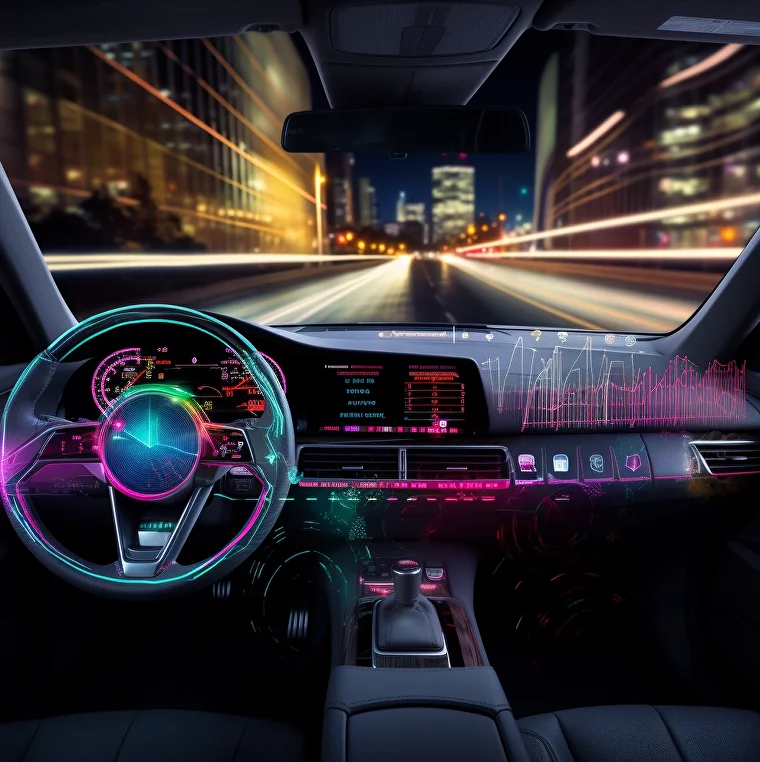
In 25 years’ time, cars’ dashboards might include elements of augmented reality. These interactive, touch-screen dashboards could allow complex data analysis for drivers who want to make sure their driving is energy-efficient or who are aiming to streamline their commute.
AR dashboards could also help drivers and passengers monitor their health, with features such as a heart rate monitor and posture scanning. Features like this would make use of cars’ increasingly advanced software to provide extra value to drivers. The popularity of products such as watches that double as fitness trackers suggests that people might relish the opportunity to check in on their health and well-being on their daily journeys.
By 2048, our expert predicted that fully autonomous vehicles might be available, using advanced sensor arrays and AI algorithms to drive with minimal human intervention. Vehicle-to-infrastructure networks could enable cars to recognize and respond to road signs by themselves, meaning that drivers would be able to totally relax, knowing that this was taken care of.
2073
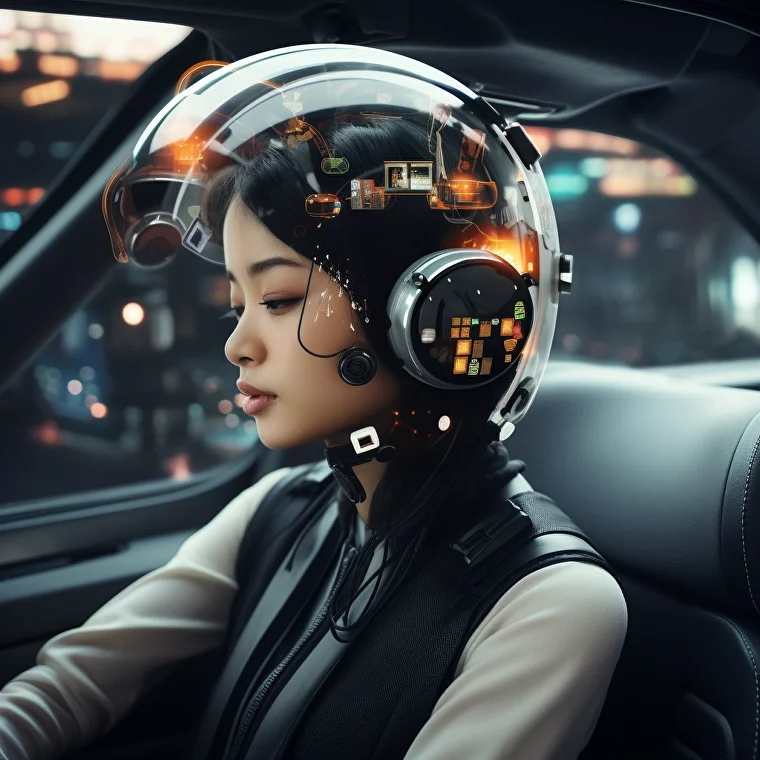

Beyond today’s dashboard interfaces, bio-integrated interfaces could make the driving experience much more sensory. Drivers could feel what the car feels, from the wind whipping past to the engine shifting into a higher gear.
A bio-integrated interface, based on recent research into cybernetics enhancements, could take a variety of forms. It could be a flexible and lightweight electronic device you wear, or a tiny sensor like a sticker. A device like this could take in digital information and transform it into signals that you can feel in your body.
The car of 2073 might also be equipped with AI that can sense your emotions in order to provide a better experience for you as you travel. A car would become more of a companion on the road, working together with you to make the journey pleasant.
If quantum computing technology is available by this time, cars could be equipped with instantaneous decision-making. Self-driving vehicles could decide the best route based on any number of factors such as traffic, weather conditions and any stops on the way to the main destination.
Car interior — seats
2033
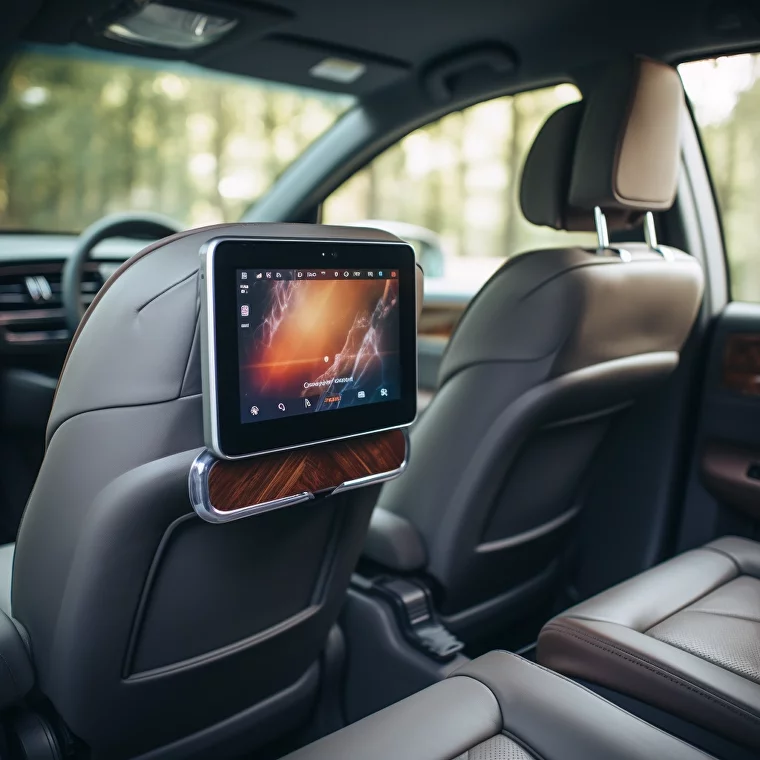
In 10 years’ time, cars might include haptic feedback systems that vibrate to transmit information. Haptic feedback technology is already sometimes used within touch screens, and developers are experimenting with using it to make driving an electric car feel more tactile. While electric cars can provide a very smooth ride, some drivers might find they miss the feeling of a powerful engine revving. This is something that haptic feedback can provide, by making the seats of the car vibrate when the driver accelerates.
Another advantage of haptic feedback would be its ability to alert the driver to information without drawing their eyes off the road – the car would be able to nudge the driver to assist with navigation or parking.
Inside the car, displays could show information such as estimated arrival time. Parents might be glad to hear that, in the future, they might not have to contend with the constant question “Are we there yet?” Immersive infotainment might also be available to help passengers of all ages pass the time.
2048
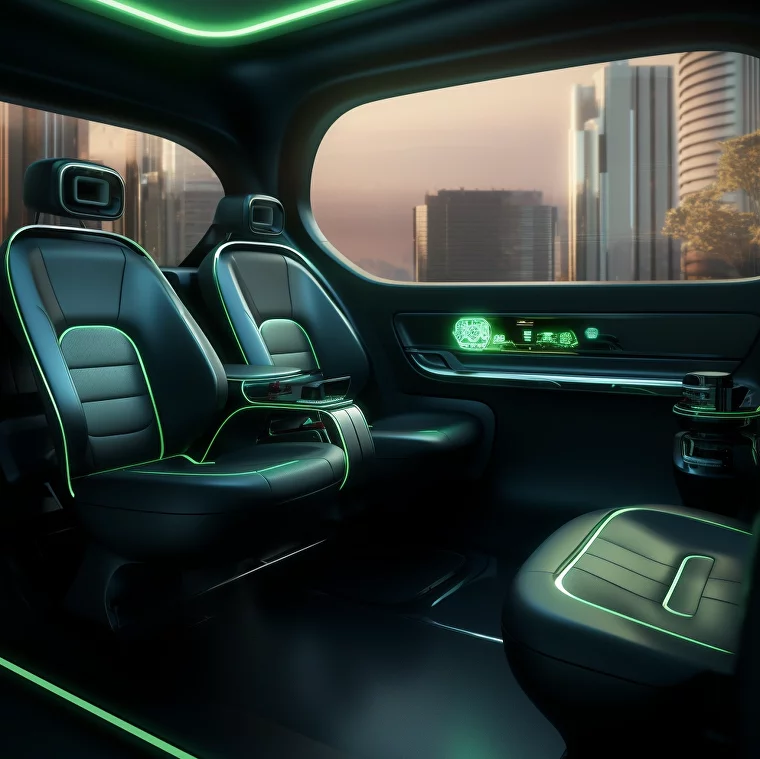
By this time, our expert predicted it would be likely that cars would be able to drive autonomously. When the car is in self-driving mode, the passengers might turn their mobile, adjustable seats around so they can face each other for a more sociable journey.
Drivers might also be able to use a non-invasive, wearable neuro-interface headset in order to control the cars’ speed, direction or signals with their thoughts. This could make driving more accessible for people with physical disabilities. It could also be a really enjoyable way to experience driving, as an alternative to letting the car drive itself.
Our expert predicted that by 2048, cars might be equipped with VR and AR technology to entertain passengers – they could play games or meet up and socialize in virtual reality. Increasingly, the car could become a space for leisure, where you look forward to spending time.
2073
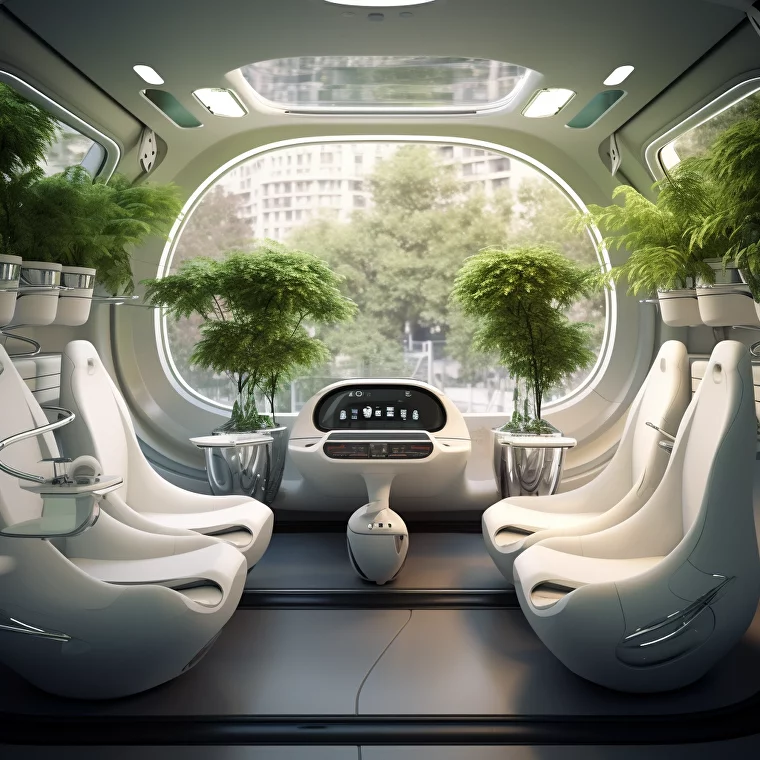

By 2073, the experience of traveling in a car might be totally different. A car 50 years from today could be a sentient mobile space with an AI mind that is fully capable of communicating with the passengers.
The interior of a car might be a multifunctional space where passengers could enjoy realistic holographic entertainment, work out during their commute or even catch up on sleep in a comfortable bed. Our expert predicted that multifunctionality could be one of the key features of cars in 50 years’ time, with modular features that change the space according to the passengers’ needs.
Cars might make use of biologically integrated systems: for example, living organisms like plants might purify the air. We could be looking at a future in which cars are not just carbon neutral, but carbon negative, cleaning the air inside and outside of the vehicle. Live plants, which could be integrated into the vehicle in terrarium feature walls, would also be a beautiful addition that would make traveling by car more relaxing.
There might be built-in high-tech features such as 3D printing or even matter replication, meaning that people would be able to use their car as an advanced workshop while they travel. This would be especially useful for craftspeople on their way to repair something, or even paramedics in futuristic ambulances who might need to create bespoke medical equipment for a patient.
We think the images Midjourney generated to help depict these cars of 2073 are wonderful to look at.
AI vs Expert
As well as using the image generator Midjourney to design cars based on our expert’s thoughts, we were interested to see what the tool itself predicted. We asked the AI to produce images of cars in the years 2033, 2048 or 2073 – as well as cars in 10, 20 and 50 years in the future.
2033
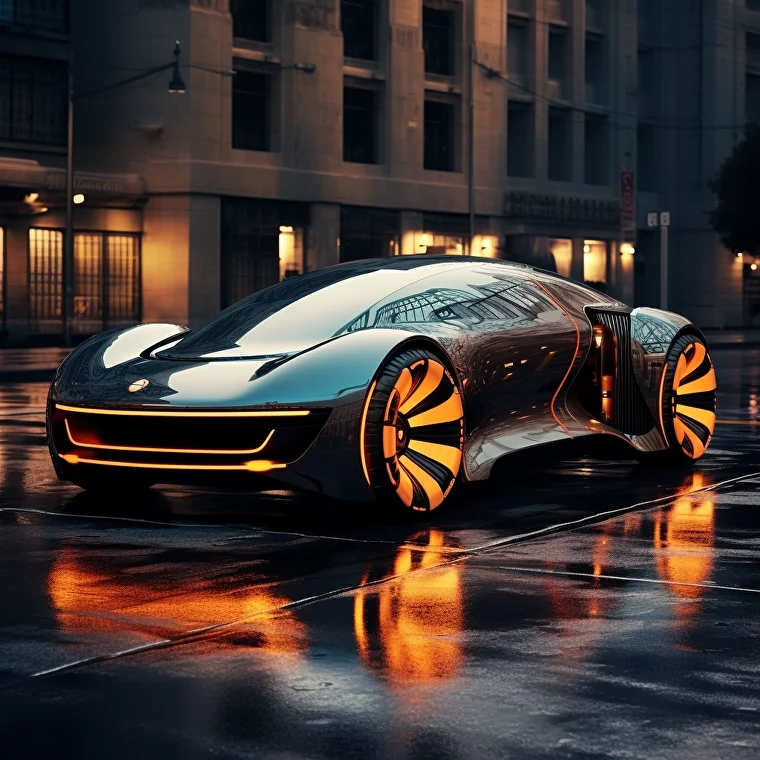
When asked to generate an image of a car for this time period, Midjourney did create something not dissimilar to what it generated based on our expert’s predictions.
This car has similar panels and strips of light for the headlights and across the grill. The AI has also added light up detailing to what must be custom wheels. This is in keeping with predictions that features previously limited to luxury supercars might become more affordable and seen more frequently – although this car does look like even in 2033, it would still be expensive!
Like the car Midjourney designed based on our expert’s industry knowledge and awareness of trends in automotive design, this car boasts aerodynamic curves and looks built for speed.
The windshield looks extremely tinted and seems to meld into the car’s paint. While this may be an accident, it is in fact reminiscent of expert predictions that cars may start to incorporate new materials that can shift between transparent and opaque. This was predicted to be further away than 10 years, but it would lead to some really interesting innovations in automotive design.
2048
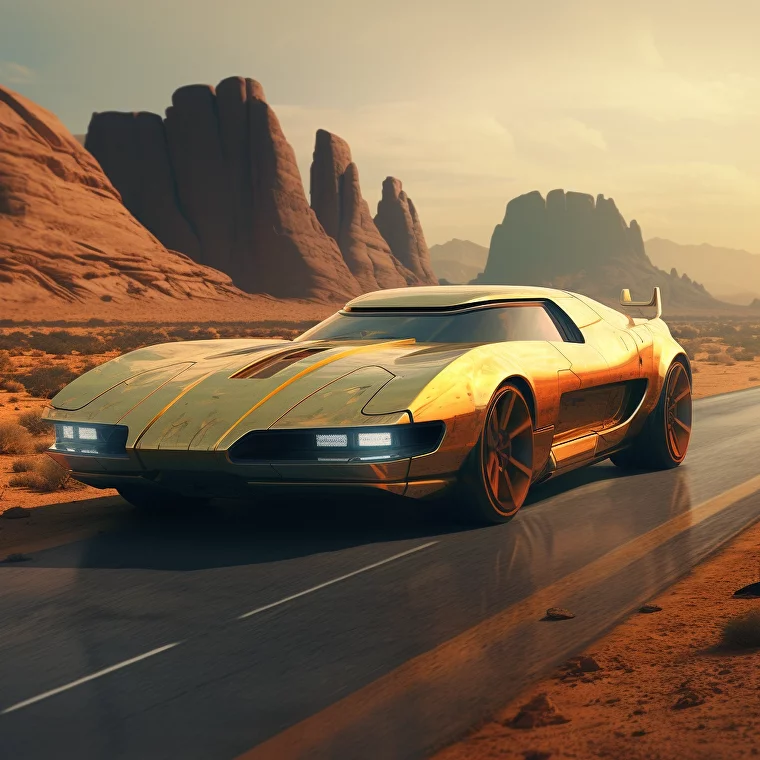
Midjourney’s impression of what cars might look like in 2048 has interesting differences from the images generated using more detailed prompts based on expert research.
Notably, while it sits low on the road, instead of smooth, rounded shapes, it has the angular look of some late 1980s sports cars like the Ferrari Testarossa or Lamborghini
Countach. It looks more retrofuturistic than just futuristic. What does Midjourney know about that we don’t? Trends are circular and automotive design is no exception, so perhaps in the years to come, we will see a return to these kinds of long, low cars with hard angles.
If not a vent, the rectangle on the bonnet looks like it could possibly be a compact solar panel, allowing the car to charge from sunlight. This would be in line with predictions that automotive manufacturers will increasingly move away from mainstream fuels and towards more sustainable alternatives.
The spoilers on the back of the car would serve to reduce drag. A feature most commonly seen on race cars and high-performance sports cars, it helps drivers reach higher speeds. Expert predictions suggest that in the future, cars might deploy adjustable spoilers without driver input. These ‘active spoilers’ are already available in some high-end cars, but this could be technology that more drivers are able to enjoy in future years.
The AI image shows the car ripping through an empty desert landscape, with bright sun bouncing off the gold paintwork. Whether this car is in keeping with expert predictions or not, it certainly makes for a very striking image.
2073
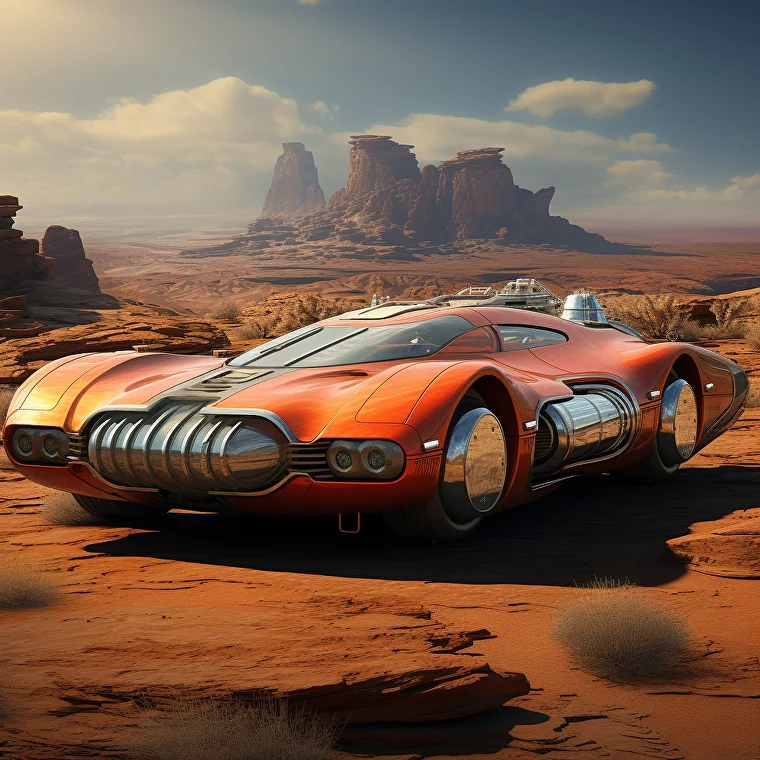
This car looks very futuristic. Sleek chrome detailing covers the machine from the stylized, outsized grill to what appear to be jet engines on the sides, which could enable the car to travel at incredible speeds.
One way Midjourney’s 2073 car differs from our expert’s predictions is that it is comparatively small. This looks less like a multipurpose space that you can travel in, and more like a traditional sports car. As such, it seems to only have space for two seats, unlike the larger vehicles predicted based on industry expertise. However, no doubt there will still be an appetite for fast two-seaters in the future, and this car looks like it would be a lot of fun to drive.
While it lacks wings or VTOL capabilities, it does appear to be hovering off the ground. It would not be possible to float like this in the desert using magnetic levitation, as this technology relies on the surface the vehicle travels along to be magnetized. However, effects like this could be achievable using air cushion technology. This is the concept that allows hovercrafts to float, creating a cushion of air just below the hull of the vehicle.
Interestingly, the desert has appeared again without being prompted. It could be a setting that Midjourney associates with the keyword ‘future’ – it makes us want to watch Mad Max!
Conclusion
It looks as if continuing technological advancements are going to lead to some very high-powered and stylish vehicles in the years to come. While AI and experts do not agree on everything, all the images we created using Midjourney have ambitious designs.
Cars in 10 years’ time will not look that different, but time-saving, safety-focused and just plain fascinating features are just around the corner. In 25 years’ time, automotive manufacturing techniques will have advanced even further, as well as the technology that will be integrated into our vehicles. And in 50 years’ time, cars could be all-singing, all-dancing flying machines!
We hope that you found these predictions interesting and exciting.
At DiscoverCars.com, we don’t have the cars of the future (nobody does!), but we are the best place to find the perfect rental car for you right now. You can find deals in over 145 countries, comparing deals from international companies.
Source from My Car Heaven
Disclaimer: The information set forth above is provided by mycarheaven.com independently of Alibaba.com. Alibaba.com makes no representation and warranties as to the quality and reliability of the seller and products.




